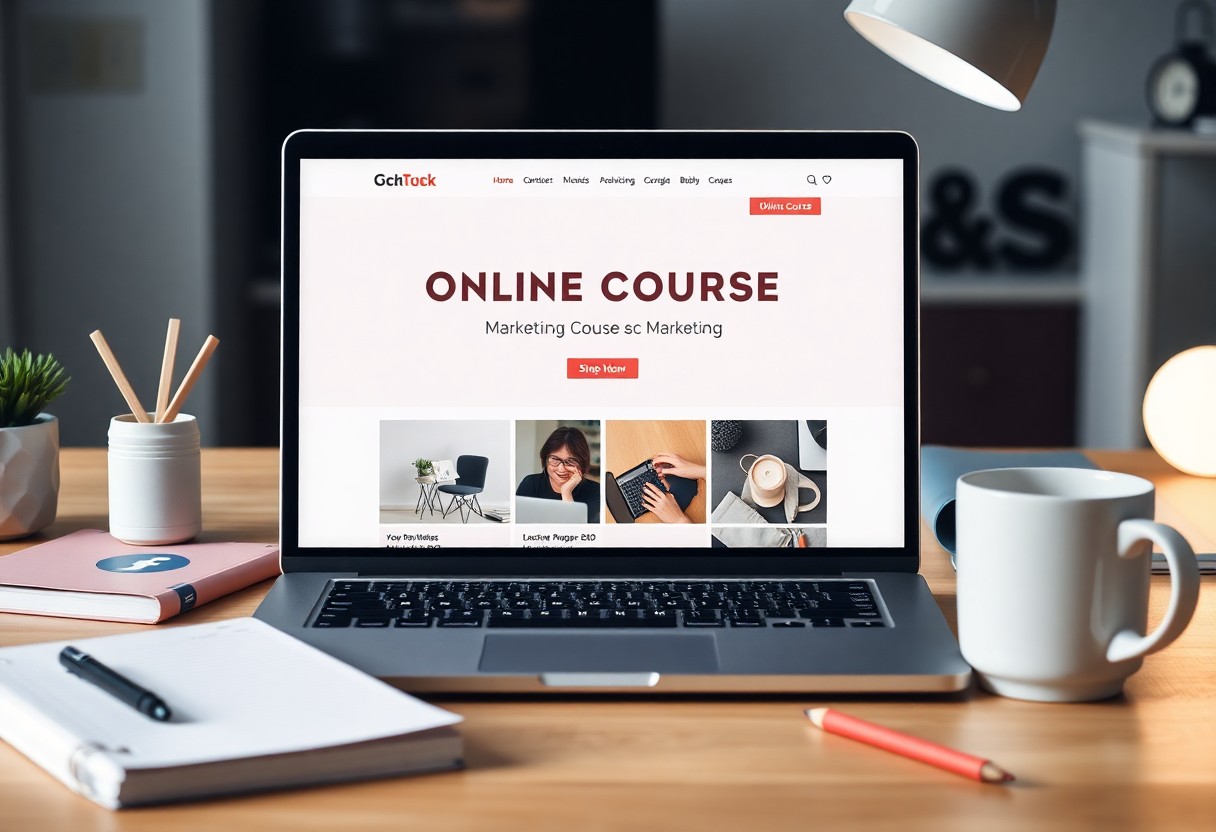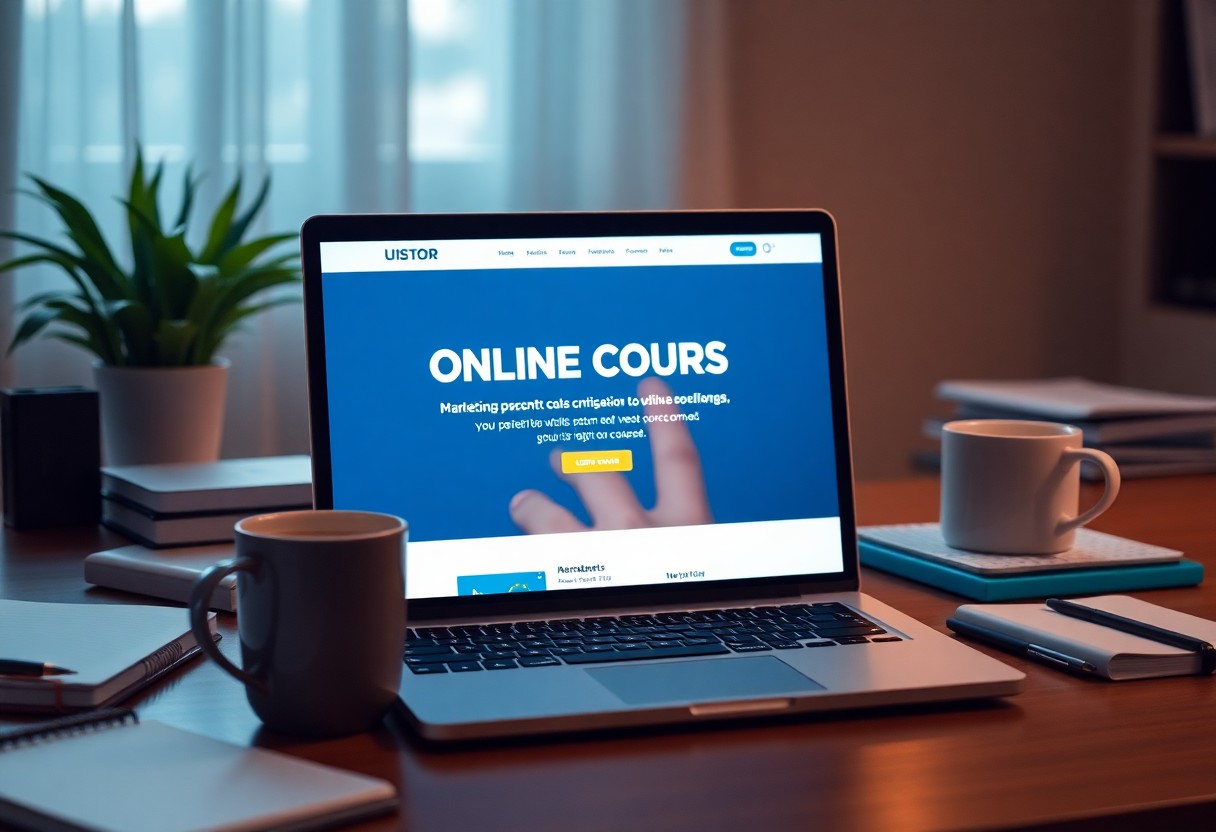There’s a lot involved in successfully marketing your online course, and this guide will walk you through every step from creation to sale. You’ll learn effective strategies to attract your target audience, build engagement, and convert interest into enrollments. Whether you’re just starting out or aiming to expand your reach, this guide provides practical insights and proven techniques to help you grow your course and achieve lasting success in the digital education market.
Key Takeaways:
- Effective marketing is imperative to convert a great course into sales by reaching and engaging the target audience.
- Content marketing, social media engagement, email campaigns, and partnerships serve as core strategies to promote courses.
- Advanced promotion tactics and website optimization help differentiate your course in a competitive market.
- Monitoring marketing performance through analytics enables continuous refinement of strategies for better results.
- Using platforms like Zenler with free accounts can provide practical tools for managing and marketing your course.
Harnessing the Power of Purposeful Course Creation
Aligning your course with a clear purpose shapes every aspect from content to marketing, giving your offering a unique identity that resonates with your ideal students. Defining outcomes linked to real-world benefits increases engagement and can significantly boost completion and referral rates. Courses designed with intention—whether to solve specific problems or fill skill gaps—often outperform generic ones. When each lesson, resource, and activity ties back to that core purpose, your marketing messages become sharper, more compelling, and easier to tailor to targeted audiences hungry for exactly what you provide.
Identifying Your Niche: How to Stand Out in a Sea of Courses
Narrowing your focus to a well-defined niche helps you avoid competing solely on price or general appeal. Instead, you become the go-to expert addressing particular challenges faced by a specific group. Research platforms like Udemy and Coursera to spot crowded categories, then identify underserved subtopics or unique angles. For instance, rather than “graphic design,” targeting “graphic design for non-profits” positions you distinctively. This clarity boosts your chances of attracting students who feel understood and valued, leading to higher conversion rates and stronger word-of-mouth marketing.
Designing Content That Sells: Crafting Engaging Learning Experiences
Interactive elements like quizzes, real-world projects, and multimedia presentations keep learners involved and increase perceived value. Structuring content into digestible modules with clear, measurable milestones encourages steady progress, preventing dropout. Examples include incorporating case studies that mirror students’ career challenges or hands-on assignments that build a portfolio. Utilizing platforms supporting gamification can amplify motivation by rewarding achievements. When your course delivers both knowledge and a satisfying user experience, it naturally attracts positive reviews and repeat enrollments.
Deepening engagement involves integrating diverse content formats such as videos, infographics, and downloadable templates to cater to various learning styles. Personalizing pathways with optional modules allows learners to focus on skills most relevant to them, enhancing relevance and satisfaction. Frequent opportunities for learner feedback permit iterative improvements, keeping your course aligned with evolving needs. This approach not only demonstrates your commitment to student success but also generates authentic testimonials and case studies that fuel your marketing campaigns with credible, persuasive social proof.
Building a Robust Pre-Launch Strategy
Your pre-launch phase sets the stage for your course’s success by carefully orchestrating awareness and anticipation. Focus on aligning your messaging, building your email list, and scheduling key promotional activities. A well-timed countdown, early bird offers, and valuable freebies can create momentum, increasing the likelihood of a strong launch day. Mapping out this phase with clear goals and milestones allows you to measure progress and adjust tactics before your course goes live.
Generating Buzz: Teaser Campaigns and Content Strategy
Teaser campaigns using bite-sized video snippets, behind-the-scenes looks, or thought-provoking questions spark curiosity and engagement. Pair these with a content calendar that strategically releases blog posts, infographics, or mini-tutorials relevant to your course topic. This drip-feed approach keeps your audience hooked, primes them for launch, and boosts shares and conversations across social channels.
Community Engagement: Creating Interest Before Your Launch
Engaging your community ahead of launch builds trust and fuels word-of-mouth promotion. Create interactive experiences such as live Q&A sessions, private groups, or challenges related to your course’s subject. Encouraging early participants to share feedback or success stories amplifies social proof and establishes genuine excitement around your upcoming course.
Digging deeper into community engagement, hosting a pre-launch webinar or exclusive workshop can significantly elevate interest. These events create direct touchpoints where you address questions and showcase your expertise, making potential students feel valued and involved. Utilizing platforms like Facebook Groups or Discord channels fosters a sense of belonging, encouraging active conversations and peer support. For instance, a course creator who launched a business workshop saw a 40% increase in early sign-ups after running a week-long challenge that energized their community and generated authentic testimonials.

Dynamic Promotional Channels for Course Marketing
Exploring multiple promotional channels allows you to diversify your marketing efforts and reach wider audiences. Combining content marketing, social media, email campaigns, partnerships, and paid ads creates a balanced strategy that maximizes visibility and conversions. For instance, integrating video content on YouTube, engaging posts on Instagram, and personalized email sequences can drastically improve student enrollment. You control the messaging and placement, harnessing each channel’s unique strengths to build momentum throughout your course launch and growth phases.
The Art of Storytelling: Content Marketing that Converts
Your content should tell a compelling story that resonates with your audience’s needs and aspirations. Craft narratives highlighting real-world challenges your course addresses and present clear solutions, using case studies or testimonials to add credibility. Combining blog posts, tutorials, and behind-the-scenes insights enables you to connect emotionally, establishing trust and guiding prospects from interest to enrollment.
Leveraging Social Media: Platforms and Strategies for Reach
Social media channels provide a powerful way to boost course awareness and community engagement. Focusing on platforms like LinkedIn for professional courses, Instagram for visual storytelling, or TikTok for short, engaging clips offers tailored approaches that drive traffic and conversions. Consistent interaction, user-generated content, and strategic hashtags amplify your reach while live sessions and polls deepen audience relationships.
Diving deeper into social media, mastering each platform’s nuances can significantly elevate your outreach. LinkedIn’s publishing tools and groups help position you as an industry authority, reaching professionals ready to invest in upskilling. Instagram’s Stories and Reels allow you to showcase tips, course sneak peeks, and student testimonials in bite-sized formats that encourage shares and saves. TikTok’s algorithm favors authentic, relatable content, so creating quick tutorials or myth-busting clips can rapidly expand your visibility. Tailoring your frequency and content types according to platform analytics ensures you optimize engagement and convert followers into students efficiently.
The Email Marketing Blueprint for Course Creators
Email marketing remains one of the most effective channels for course promotion, delivering direct access to interested leads. Segmenting your audience by interest or behavior allows for personalized messaging that resonates. Incorporating automated sequences, such as welcome series and cart abandonment reminders, can boost conversions by up to 30%. Well-crafted subject lines with clear value propositions increase open rates and engagement, turning prospects into paying students with consistent, relevant communication.
Building Your List: Strategies for Effective Lead Generation
Growing a targeted email list starts with offering irresistible lead magnets that solve a specific problem your ideal student faces. Free mini-courses, downloadable guides, or exclusive webinars work well. Use optimized signup forms on your course website and social media channels, paired with clear calls-to-action. Partnering with complementary creators or running joint giveaways can rapidly expand your reach. Tracking which channels generate the highest quality leads lets you double down on your most effective list-building tactics.
Crafting Compelling Campaigns: Nurturing Leads into Students
Creating email campaigns that guide leads from interest to purchase requires storytelling that highlights your course’s unique benefits. Leverage social proof with testimonials and case studies, and break down complex concepts into digestible insights. Mix various content formats—videos, quizzes, and tips—to maintain engagement. Time-sensitive offers and exclusive bonuses create urgency while delivering real value, fostering trust and motivating subscribers to enroll.
Beyond standard promotional emails, nurturing campaigns benefit from educational sequences that address common objections and questions. For instance, sending a drip series that gradually introduces core course concepts while showcasing success stories helps build credibility over time. Personalized follow-ups based on user behavior, such as clicks or page visits, also enhance relevance. Integrating feedback requests and interactive content within your emails fosters two-way communication, deepening the relationship and increasing the likelihood of enrollment.

Strategic Collaborations: The Impact of Partnerships and Affiliates
Strategic partnerships and affiliate programs can dramatically broaden your course’s reach beyond your immediate network. By aligning with industry influencers, complementary course creators, or niche communities, you tap into their engaged audiences, accelerating enrollments and enhancing credibility. Leveraging external platforms and trusted voices often results in higher conversion rates at lower acquisition costs, turning collaborations into powerful growth engines for your course business.
Finding the Right Partners: Aligning Interests for Mutual Benefit
Seek partners whose audience and values closely match your course’s focus. For instance, a fitness course partnering with a nutrition blogger complements both offerings, creating cross-promotional opportunities that benefit both sides. Vet potential collaborators by their engagement rates, reputation, and willingness to actively promote. Shared goals and transparent communication cultivate relationships that drive sustained, mutually rewarding results.
Creating Affiliate Programs: Turning Fans into Ambassadors
Affiliate programs transform loyal students and advocates into sales champions by offering commissions for referrals. This incentive motivates your community to actively promote your course, expanding your sales funnel organically. Providing affiliates with ready-made marketing assets and tracking tools maximizes their success and your program’s overall performance.
Effective affiliate programs combine clear commission structures—often between 20% to 40% per sale—with easy-to-use dashboards for affiliates to monitor earnings and track their impact. Regular communication, such as newsletters highlighting new promotions or bonuses, keeps affiliates engaged and motivated. Case studies show courses leveraging affiliates can increase sales by up to 50%, illustrating how turning fans into ambassadors fuels exponential growth while building a supportive marketing ecosystem around your brand.
Continuous Improvement Through Analytics and Feedback
Leveraging analytics and direct feedback helps you refine your marketing efforts and enhance your course delivery. By continually monitoring how students engage with your content and where drop-offs occur, you can pinpoint areas for improvement. Combining quantitative data from tools like Google Analytics or your course platform with qualitative insights from surveys and reviews enables you to optimize your messaging, pricing, and course structure for greater impact and increased sales.
Measuring What Matters: Key Metrics for Course Success
Focus on metrics such as conversion rates, student completion rates, and engagement levels to gauge your course’s performance. Monitoring the click-through rate on your email campaigns or social media ads reveals how effectively you capture attention, while tracking average watch time identifies how compelling your lessons are. These key indicators guide your decisions to align marketing tactics with learner behavior and purchase patterns, helping you maximize ROI.
Adapting Your Approach: Using Insights for Future Launches
Insights from previous launches inform adjustments in your marketing and course content strategies. If data shows a certain promotion channel outperforms others, consider allocating more budget there next time. Noticing feedback about confusing modules can prompt revisions that improve learner satisfaction. Iterating based on real-world results sharpens your approach, increasing effectiveness and building momentum for subsequent course unveilings.
Continuous refinement involves dissecting which messaging resonated most, identifying promotional timing that boosted sign-ups, and uncovering demographic trends within your audience. For example, if you find that webinars generated a 30% higher conversion rate compared to blog posts, integrating more live events into your funnel may yield better returns. Similarly, adapting course pacing or adding interactive elements based on learner feedback increases engagement and referrals. Each relaunch becomes an opportunity to apply these lessons and elevate your overall marketing strategy.
Summing up
Summing up, this complete guide to course marketing provides you with imperative strategies to successfully promote your course from creation to sale. By leveraging content marketing, social media, email campaigns, partnerships, and advanced promotion tactics, you can effectively reach and convert your target audience. Continuously optimizing your website and tracking your results will help you refine your approach and grow your course business over time. With persistence and creativity, you are equipped to navigate the dynamic digital marketing landscape and achieve your course sales goals.
FAQ
Q: What are the first steps to take when beginning course marketing?
A: Start by clearly defining your target audience and understanding their needs. Develop a marketing plan that includes content creation, social media engagement, and email campaigns to build interest before your course launches. Preparing a well-optimized course website will also help convert visitors into students.
Q: How can content marketing help promote my online course effectively?
A: Content marketing allows you to showcase your expertise and provide value to potential students through blog posts, videos, or free resources. This builds trust and attracts an audience interested in your course topic, which can lead to higher enrollment rates when you launch your course.
Q: What role does email marketing play in selling online courses?
A: Email marketing enables you to nurture leads by sending targeted messages, course updates, and exclusive offers directly to potential students. Building and maintaining an engaged email list helps maintain interest and increases the chances of converting prospects into paying students.
Q: How important is measuring marketing performance and making adjustments?
A: Tracking your marketing efforts with analytics tools helps identify which strategies are most effective and where improvements can be made. Regularly reviewing your data allows you to fine-tune your approach to better connect with your audience and maximize your course sales over time.
Q: What are some advanced promotion tactics to help a course stand out?
A: Consider tactics such as collaborating with industry partners, running targeted social media ads, hosting live webinars or Q&A sessions, and offering limited-time discounts. These strategies can increase your course’s visibility, build community engagement, and encourage more enrollments.

